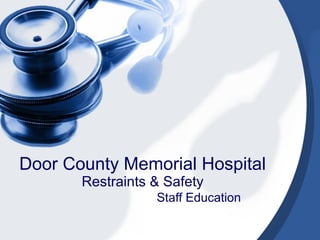
Patient Restraints
- 1. Door County Memorial Hospital Restraints & Safety Staff Education
- 2. Purpose: The purpose of this presentation is to provide nursing staff with information on how to care for patients in need of restraints • Goal: The goal of this self-directed presentation is to educate staff to use restraints as a last resort and, when used, to provide a safe environment for the patient in restraints. • Objectives: After completing this presentation, the participant will be able to: – Explain what measures to try before putting a patient in restraints. – Describe the type of order that must be written for restraints. – Describe methods to safely care for a patient in restraints.
- 3. Restraint Safety Information • A physical restraint is any manual method, physical or mechanical device, material, or equipment that immobilizes or reduces the ability of a patient to move his or her arms, legs, body, or head freely. • A chemical restraint is a drug or medication that is used as a restriction to manage the patient’s behavior or restrict the patient’s freedom of movement and is not a standard treatment or dosage for the patient’s condition. • Seclusion is the involuntary confinement of a patient alone in a room or area from which the patient is physically prevented from leaving. • The use of seclusion or medication as a restrictive intervention, restraint and/or chemical restraint is not employed at DCMH .
- 4. There are many potential risks and side effects of restraint use: • Psychological/Emotional: • Increased agitation, hostility, aggression and combativeness • Feelings of humiliation, loss of dignity • Increased confusion • Fear • Physical: • Pressure ulcers, skin trauma (tears, cuts, bruises) • Bone loss (demineralization) from decreased weight bearing activity • Decreased muscle mass, tone, strength, endurance • Deconditioning leads to stiffness, contractures, loss of balance, increased risk of falls • Reduced heart and lung capacity, increased risk of orthostatic hypotension and respiratory infection • Physical discomfort, increased pain • Increased constipation, increased risk of fecal impaction • Increased incontinence and risk of urinary tract infection due to urinary stasis • Obstructed and restricted circulation • Reduced appetite • Dehydration • Death
- 5. All alternatives must be tried before restraints are to be used. This includes: • Offer bedpan or bathroom every 2 hours • Offer fluids and nourishment frequently, keep water within reach • Provide diversional activity • Decrease stimuli and noise • Provide change of position, up to chair, ambulation • Have patient wear glasses and/or hearing aides • Activate bed alarm • Increase observation – Ask family to sit with patient – Alert other staff to be observant – Move patient to a room near the nurse’s station • If the patient is interfering with his medical equipment – Educate frequently not to touch the treatment device – Place the device out of site if possible – Cover the device (i.e. wrap I.V. site with Coban or Kerlex)
- 6. Important Reminders • Document all alternatives that were tried before restraint use. The decision to use restraints must include the full awareness of the patient’s rights, dignity, modesty and well being. Patients and families must be provided with information on restraints to allow for an informed decision. This should include providing them with “Information Sheet: Using Restraints Safely.”
- 7. Patient and Family Education: • Discuss with patient and family safety concerns, i.e. risks of pulling out IV. • Explain the behavior that initiated restrain use • Explain the alternatives tried • Assure that safety/comfort will be met
- 8. Restraint Orders Situational Medical Behavioral -May apply in * Initiation of -Obtain written or emergency, but get verbal order within Restraints 12 hours of initiation, doctor order with in 1 hour. Dr must do face- (ALWAYS after physician exam to-face assessment within 24 hours. within 1 hour of alternatives restraint initiation. tried) - In accordance with - Every 24 hours following limits up to a total of 24 hours: * Renewing - 4 hrs for adults 18 and Order up. - 2 hrs for children 9-17 yrs of age. -1 hr for children nine and under.
- 9. Safe application of wrist/ankle restraints: • Always use quick release knots • DON’T tie to side rails or cross behind patient • Keep side rails up at all times • Have call light in reach • Keep sharp objects away from patient • Never use a draw sheet tied around the patient’s waist as a restraint • Use only hospital approved soft restraints on wrists and ankles • If leather restraints are required: keep padding under leather, keep key behind headboard or taped to the wall above headboard at all times
- 10. Monitor a patient in restraint every 15 minutes for: • Signs of injury • Circulation and range of motion • Comfort • Readiness for discontinuation of restraint
- 11. Documentation (on the restraint management flow sheet) every 2 hours for: • Release the patient, turn and position • Institute a trial of restraint release • Hydration and nutrition needs • Elimination needs • Comfort and repositioning needs
- 12. Correct way to tie a quick –release knot. To make a quick-release knot, make a regular over hand knot, but slip a loop (instead of the end of the strap) through the first loop.
- 13. Reminder- on restraints • Remember not to tie to side rails or cross behind the patient.
- 14. Additional Information • For additional information on restraints refer to: - Restraints policy, found on the J drive in the Administrative Policies under Patients Rights & Organizational Ethics. - MedFilms, Educational Video: “Patient Restraints and Seclusion” located in Nursing Education Office.
- 15. References: • Door County Memorial Hospital. (2008, July). Policy and Procedures: Administrative Policies, Patient Rights & Organizational Ethics. Restraints. Sturgeon Bay, WI • Carter, Pamela J., (2007) Lippincott's Essentials for Nursing Assistants: A Humanistic Approach to Caregiving (pp 279-286). Lippincott Williams & Wilkins.